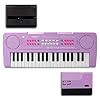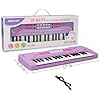Table of Contents
Introduction to Mastering the Art of Piano Improvisation
Piano improvisation is the art of spontaneously creating music as you play. Improvisation allows musicians to explore their creativity and express emotions without the constraints of scripted notes. Mastering this skill can significantly enhance your versatility and understanding of music. This introductory guide will explore the fundamental concepts and techniques essential for any pianist aspiring to improvise confidently and effectively.
Introduction to Basic Improvisation Techniques
Mastering the art of piano improvisation opens a world of creative possibilities and enhances musical expression. Improvisation is not just a skill for jazz musicians, but is also invaluable for classical, rock, pop, and electronic music artists. The following sections outline the basic techniques integral to becoming a proficient improviser on the piano. Each technique encourages pianists to explore their musical intuition, expand their vocabulary, and develop their unique voice on the keyboard.
Best Choice Products 61-Key Electronic Keyboard Piano Portable Electric Keyboard Complete Beginner Set w/LED Screen, Stand, Bench, Headphones - Black
13% OffRockJam 61 Key Keyboard Piano Stand With Pitch Bend Kit, Piano Bench, Headphones, Simply Piano App & Keynote Stickers
$129.99 (as of December 20, 2025 13:23 GMT -08:00 - More infoProduct prices and availability are accurate as of the date/time indicated and are subject to change. Any price and availability information displayed on [relevant Amazon Site(s), as applicable] at the time of purchase will apply to the purchase of this product.)Piano Star
$0.00 (as of December 20, 2025 13:23 GMT -08:00 - More infoProduct prices and availability are accurate as of the date/time indicated and are subject to change. Any price and availability information displayed on [relevant Amazon Site(s), as applicable] at the time of purchase will apply to the purchase of this product.)Keyboard Piano for Kids, BIGFUN 37 Keys Toddler Piano Multifunction Music Educational Instrument Toy, Electronic Kids Keyboard for 3-7 Year Old Girls and Boys (Purple)
15% OffUnderstanding Chord Progressions
The backbone of piano improvisation lies in understanding chord progressions. Recognizing common progressions such as the 12-bar blues or the II-V-I jazz sequence allows improvisers to anticipate and navigate the changes smoothly. Developing this knowledge helps in crafting coherent solos that logically flow from one chord to the next, providing a solid foundation upon which melodies can be built.
Exploring Scales and Modes
Scales and modes provide the basic building blocks for melodic improvisation. Familiarity with the major and minor scales is essential, while exploring modes like Dorian, Mixolydian, or Lydian can add unique colors to your improvisational palette. Understanding how these scales and modes interact with different chord types is crucial for crafting musically interesting and contextually appropriate solos.
Motif Development
A motif is a short musical idea, a pattern, or a thematic element that can be developed and varied throughout a piece. In improvisation, beginning with a simple motif and then expanding it through variation techniques—such as inversion, retrograde, augmentation, and diminution—can provide a cohesive structure to an improvisation, making it more engaging and intelligible.
Playing by Ear
The ability to play by ear is invaluable in improvisation. This skill allows musicians to reproduce and adapt melodies and harmonies they hear, facilitating the spontaneous composition of music in real time. It enables a deeper connection with the music and fosters a more intuitive performance style, allowing the improviser to naturally respond to the musical environment.
100 of the Most Beautiful Piano Solos Ever | Piano Sheet Music Book for Intermediate Players | Classical Pop and Jazz Standards | Essential Solo Repertoire for Adult Students Teachers and Pianists
28% OffP71 Digital Piano Review and Guide
$0.00 (as of December 20, 2025 15:53 GMT -08:00 - More infoProduct prices and availability are accurate as of the date/time indicated and are subject to change. Any price and availability information displayed on [relevant Amazon Site(s), as applicable] at the time of purchase will apply to the purchase of this product.)The Piano Proficiency Exam Review Book
$26.99 (as of December 20, 2025 19:57 GMT -08:00 - More infoProduct prices and availability are accurate as of the date/time indicated and are subject to change. Any price and availability information displayed on [relevant Amazon Site(s), as applicable] at the time of purchase will apply to the purchase of this product.)Ready for Theory Prep B Review Book (Ready for Theory Piano Review Books)
$10.95 (as of December 20, 2025 15:53 GMT -08:00 - More infoProduct prices and availability are accurate as of the date/time indicated and are subject to change. Any price and availability information displayed on [relevant Amazon Site(s), as applicable] at the time of purchase will apply to the purchase of this product.)Developing Creativity and Expression
Improvisation is ultimately about personal expression. Developing a keen sense of dynamics, phrasing, texture, and rhythmic diversity can make improvisations more expressive and emotionally resonant. Encouraging creativity by experimenting with different sounds, including non-traditional techniques like using the piano strings or body, can also enhance the uniqueness of your musical voice.
How to Use Scales in Piano Improvisation
Using scales effectively in piano improvisation involves more than just playing them up and down. To truly master their use, consider the following strategies:
How to Use Arpeggios in Piano Improvisation
Arpeggios are a foundational element when improvising on the piano. They can outline chord changes and enrich musical texture. To effectively incorporate arpeggios, consider these strategies:
Practicing Free-Form Playing to Develop Creativity
Mastering the art of piano improvisation involves exploring and developing one’s creative abilities. An effective way to enhance creativity is through practicing free-form playing. This technique focuses on unrestrained expression without the confines of predefined rules or structures. Here is an elaborate discussion on how to engage in free-form playing to foster creativity.
Understanding Free-Form Playing
Free-form playing is essentially a stream-of-consciousness performance on the piano. The pianist allows their hands to move freely over the keys, guided by their feelings and instincts rather than specific musical rules. This practice helps musicians tap into their unique style and preferences.
Benefits of Free-Form Playing
Engaging in free-form playing provides several benefits:
How to Practice Free-Form Playing
To effectively practice free-form playing, follow these steps:
Recording and Reflecting
After each free-form playing session, it’s useful to record and listen back to your performance. This practice allows you to reflect on your playing and discover patterns or ideas you might want to develop further. Use these recordings to inspire more structured improvisations or compositions.
Incorporating Free-Form Exercises
Integrate free-form playing into your regular practice routine, dedicating specific segments of your practice session to this approach. Alternating between structured learning and free-form play can enhance both your technical skills and creative capacities.
Applying Improvisation in Jazz
Improvisation is a cornerstone of jazz piano. Typically, a musician will play the melody of a jazz standard and then improvise new melodies over the song’s chord progressions. Jazz improvisation incorporates various scales, notably the blues scale, bebop scale, and modes, alongside stylistic elements such as swing, syncopation, and complex chords. Mastery in jazz improvisation involves a deep understanding of music theory, listening skills, and a broad repertoire of licks and motifs. Essential techniques include chord voicings, using passing tones, and mastering the rhythmic nuances particular to jazz.
Applying Improvisation in Blues
Blues piano improvisation relies heavily on the blues scale and typically adheres to a 12-bar blues structure. Expressiveness and emotional depth are crucial, with emphasis often on rhythmic precision and repetition. A blues pianist might utilize techniques like grace notes, crushed notes, and varied dynamics to enhance the expressive quality of their improvisation. Interaction with the dominant chords through the application of the flat third, flat fifth, and flat seventh intervals are significant to crafting authentic blues tonality.
Applying Improvisation in Classical Music
Despite a common perception of strict adherence to written music, improvisation does exist in classical piano performance and composition. Historically, improvisation was a valued skill for classical musicians with figures like Mozart and Beethoven being renowned improvisers. Improvisation in classical music can include embellishing melodies, creating real-time variations, or cadenzas in concertos. Modern classical pianists may improvise transitions between pieces or interpret written material with personalized embellishments.
Applying Improvisation in Rock and Pop
In rock and pop contexts, piano improvisation might not follow a strict theoretical basis as in jazz or blues but focuses more on melodic improvisation and building upon chord progressions typical to the genre. Improvisers will utilize scales such as the major and minor pentatonic scales to craft solo sections or to enhance sections of a song. Rock and pop improvisation requires a good sense of timing, use of appropriate stylistic elements like rhythmic patterns, and often a strong sense of melody.
Applying Improvisation in Folk Music
Folk music often presents a rich area for improvisational practice due to its varied ethnic roots and styles. Improvisation might involve varying a tune’s melody subtly to fit with rhythmic changes or regional stylistic nuances. Scales and modal improvisation play a crucial role, particularly in folk styles influenced by non-Western music traditions.
Applying Improvisation in Experimental and Avant-Garde Music
Improvisation in experimental and avant-garde music can go beyond traditional boundaries of musical theory, exploring atonality, dissonance, and unconventional rhythms. Performers may use improvisation to explore new sound textures, dynamic structures, and interactive performance techniques, often incorporating technology and unconventional playing methods to push the musical exploration even further.
Recording Your Improvisations
Recording your piano improvisations is a vital step in mastering the art of improvisation. It serves multiple purposes: it allows you to listen back to your playing, observe patterns or habits, and track your progress over time. Utilizing modern recording technology, such as digital audio workstations (DAWs), smartphones, or dedicated audio recorders, can provide high-quality recordings that capture the nuances of your performance.
To get started, ensure your recording environment is quiet and free from unnecessary disturbances. Use a good-quality microphone positioned correctly relative to the piano to capture a clear and balanced sound. After recording, label and save your files systematically to keep your improvisations organized for future reference.
Analyzing Your Improvisations
After recording your improvisations, the next step is a thorough analysis. This process helps identify your strengths and areas for improvement. Listen back to your recordings and note what worked well and what didn’t. Consider aspects like melody, harmony, rhythm, and emotional expression.
Use tools such as music notation software to transcribe your improvisations, which makes it easier to visualize and analyze the musical structure. You might also want to compare your recordings with performances by seasoned improvisers to gain additional insights and inspiration.
Reflect on your improvisational approach, ask yourself questions about your choices and experiment with different ways to revise or develop your ideas. This reflective practice will enhance your ability to improvise more thoughtfully and creatively in future sessions.
Conclusion: Mastering the Art of Piano Improvisation
In conclusion, mastering the art of piano improvisation is a rewarding journey that enhances musical expression and personal creativity. Through dedicated practice, understanding of music theory, and continuous exposure to different styles, pianists can develop the confidence and skills necessary to improvise effectively. Emphasizing the importance of listening, experimentation, and emotional connection will ensure that improvisation becomes not only a technique but a profound means of artistic communication. As musicians explore this dynamic aspect of piano playing, they unlock new levels of artistic achievement and personal satisfaction.






































